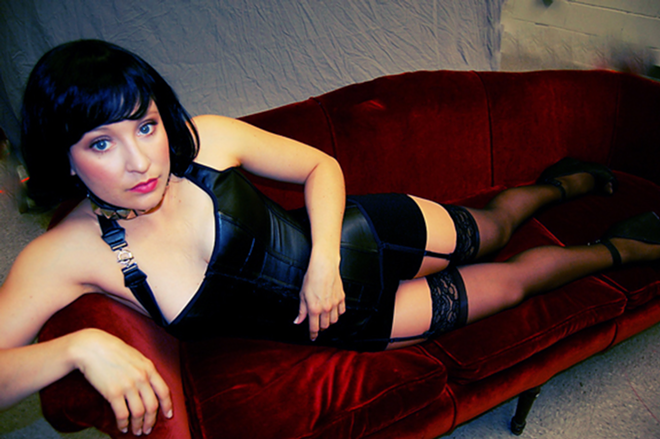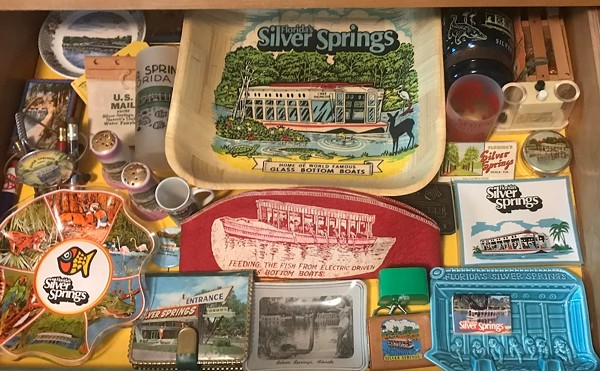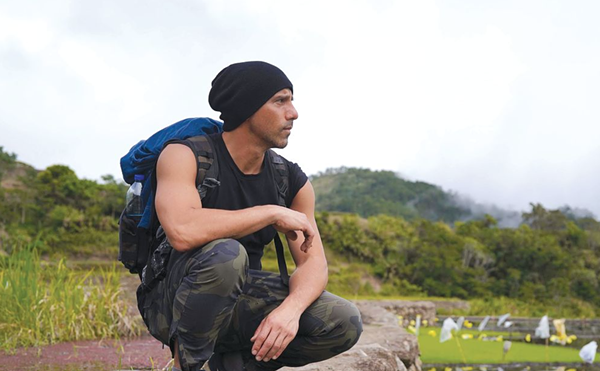Who is Vanda Jordan? That’s the question that makes Venus in Fur, currently playing at Stageworks, such a tantalizing experience. Vanda tells playwright/director Thomas Novachek that she’s just an actress auditioning for a quickly-scanned part, but she seems to know the role — of a 19th-century dominatrix also named Vanda — down to the last detail. She claims that Thomas’s adaptation of Sacher-Masoch’s Venus in Furs is sexist soft porn, but she’s unusually quick to strip to her underwear, and seems aggressively sexual even after hearing that Thomas lives with his fiancée. Then there’s the problem of the large bag she carries, which for some strange reason includes a frock coat from 1869 that fits Thomas perfectly: How’d she happen to buy it? What about the footman’s jacket she unpacks later? Even the thunder and lightning that occasionally punctuate Vanda and Thomas’ dialogue is puzzling: Is it natural? Symbolic? Is anything we see to be taken at face value?
If these questions sound intriguing, you’ll no doubt enjoy David Ives’ surprising play and the solid production it’s receiving in the Channel District of Tampa. This is theater-as-brain-twister, an entertaining mind game that’s also erotic and stylish and always on the edge of revealing something important about the war between the sexes. If it never fully crosses that line — if it finally says little more than “turnabout is fair play” — still, Venus in Fur is clever and unpredictable and shockingly ancient (I can’t say more lest I spoil your fun). As directed by Anna Brennen and Caroline Jett, it may not shatter your worldview, but it’ll challenge you to think through what you do believe and why. Not many other plays can claim as much.
It all begins with a phone call Thomas shares with his fiancée after a fruitless day of auditions. Standing in a warehouse room-turned rehearsal space, he fumes at the actresses who have wasted his time, employing words like “incompetent” and “stupidity.” Then there’s thunder and lightning — and Vanda arrives. She’s late, she’s flustered, she’s chatty, and she’s clearly no one exasperated Thomas wants to deal with. Right off the bat, he tells her she’s wrong for the part; but she’s remarkably persistent, and he agrees to let her read. Vanda’s performance is terrific: She falls into the role of Vanda Dunayev like it was written for her, and encourages Thomas to play Kushemski, her masochistic opposite, even when the efficient theater artist wants to cut corners.
As the play-acting continues, it becomes harder to determine what’s scripted and what’s authentic. Is it the character Vanda who demands that Kushemski become her slave for a year, or is it the real Vanda contracting with Thomas? Is she just being provocative when she claims that Thomas’ fiancée Stacy sent her to the audition, or is she really there to test Thomas’ fidelity? As the idea of the audition gets lost in a thicket of motives and mysteries, Thomas and Vanda increasingly test the threshold of the possible. Someone’s naked psyche is going to be exposed here. Someone is going to have to pay for someone’s arrogance.
Georgina McKee plays the part of Vanda, and it’s a winning performance. McKee as Vanda is a Romantic idea of the Mysterious Feminine, now a predator, now a victim, now a comrade, now an enemy. There’s no limit, it would seem, to what this woman can represent — she even asks, at one point, “Was I ever here?”
As Thomas, Brendan Ragan is sturdy, if not quite as interesting: that he’s as masochistic as Kashemski is never really in doubt, though the play would be more interesting if the issue were undecided. Further, Ragan as Thomas seldom seems capable of competing with Vanda’s chameleon-like changes. This is probably a flaw in Ives’ writing of the character, but it wouldn’t hurt if the actor compensated in performance. Aside from that too-slick design of the rehearsal space, the show’s look is just right: Vanda’s racy underthings are designed potently by Melinda Kajando, and the perhaps-not-random flashes of lightning are nicely created by Karla Hartley.
The ending of Venus in Fur is the most belief-testing thing about the play, and I have to admit that, for me, it doesn’t work. But I’m sufficiently troubled by it to want to know whether Ives intends to be taken seriously, or whether he’s just making one last assault on his audience’s assumptions. In any case, it’s not often that I’m as challenged by a play as I am by this one, and I think most other theatergoers will feel the same.
Watch it thoughtfully, if you go. Don’t jump to conclusions. And don’t blink.



















